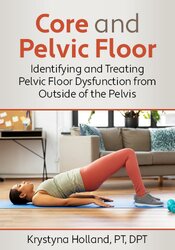Navigating the Complexities of Pelvic Health & Intimacy

While our pelvises are at the center of our bodies, discussions about pelvic health are just starting to pop up around the margins of our consideration. As a dedicated pelvic floor physical therapist, I've been honored to guide numerous individuals towards improved pelvic well-being. Whether it's facilitating pain-free intimacy for someone or supporting postpartum mothers in regaining their strength, the depth and impact of pelvic floor therapy cannot be overstated.
In just a week, my practice might see a diverse array of cases: guiding a non-binary individual through cervical pain, supporting a postpartum mother feeling neglected by her OB/GYN, or assisting a cisgender man with rib pain against a backdrop of a complicated medical history. These varied encounters highlight the adaptability and essential nature of pelvic floor therapy.
One of the most common concerns that my patients come in with is difficulty participating in physical intimacy due to pain. As long as the patient is comfortable, no topic is off limits. There is no such thing as TMI in my office. We talk about positions, lubrication, hormones, and the overarching sentiment of safety during intimacy. The guiding principle? Let’s get you to your goals in a way that aligns with your life.
Sometimes that means exercises, either of the pelvic floor directly, or muscles in the systems it plays a role in. Kegels are a highly contested topic on the internet these days, but some of the best literature we have for improving pelvic floor muscle function looks at kegels, or pelvic floor muscle contractions. The most important consideration in kegel prescription is identifying the appropriate patient, and teaching them in a way that ensures a movement through the pelvic floor’s full range of motion. (My favorite cue is to have folks breathe in, trying to expand their ribs 360 degrees, and as they exhale, to think about picking up a marble with their vagina or rectum.)
Our interventions are sometimes the least impactful part of our treatment. I know you’ve had experiences where the way you delivered the intervention, the space you left for patients to tell you their story, and the support you provided during the visit were the aspects of care that helped the most. Trauma informed, inclusive, and affirming healthcare isn’t about being politically correct or extra nice. It’s about concrete skills that leave space for our patients’ nervous systems to do the hard work of healing. We know that language matters. Being intentional about the language we use and the way we use it is one more way to ensure we are providing the care that our patients deserve.
Ultimately, our discussions might span Kegels, inclusive care, or other facets of pelvic health, but our mission is unwavering: delivering empathetic, knowledgeable, and effective care to all.
In just a week, my practice might see a diverse array of cases: guiding a non-binary individual through cervical pain, supporting a postpartum mother feeling neglected by her OB/GYN, or assisting a cisgender man with rib pain against a backdrop of a complicated medical history. These varied encounters highlight the adaptability and essential nature of pelvic floor therapy.
One of the most common concerns that my patients come in with is difficulty participating in physical intimacy due to pain. As long as the patient is comfortable, no topic is off limits. There is no such thing as TMI in my office. We talk about positions, lubrication, hormones, and the overarching sentiment of safety during intimacy. The guiding principle? Let’s get you to your goals in a way that aligns with your life.
Sometimes that means exercises, either of the pelvic floor directly, or muscles in the systems it plays a role in. Kegels are a highly contested topic on the internet these days, but some of the best literature we have for improving pelvic floor muscle function looks at kegels, or pelvic floor muscle contractions. The most important consideration in kegel prescription is identifying the appropriate patient, and teaching them in a way that ensures a movement through the pelvic floor’s full range of motion. (My favorite cue is to have folks breathe in, trying to expand their ribs 360 degrees, and as they exhale, to think about picking up a marble with their vagina or rectum.)
Our interventions are sometimes the least impactful part of our treatment. I know you’ve had experiences where the way you delivered the intervention, the space you left for patients to tell you their story, and the support you provided during the visit were the aspects of care that helped the most. Trauma informed, inclusive, and affirming healthcare isn’t about being politically correct or extra nice. It’s about concrete skills that leave space for our patients’ nervous systems to do the hard work of healing. We know that language matters. Being intentional about the language we use and the way we use it is one more way to ensure we are providing the care that our patients deserve.
Ultimately, our discussions might span Kegels, inclusive care, or other facets of pelvic health, but our mission is unwavering: delivering empathetic, knowledgeable, and effective care to all.
Ready to dive deeper into my proven tips and tools for external pelvic health?

Contrary to popular belief, pelvic floor dysfunction (PFD) isn't exclusive to mothers. In fact, 1 in 3 women in primary care settings face PFD challenges, from urinary issues to pelvic pain. Gain a holistic overview of pelvic anatomy, the function of pelvic floor muscles, and their interplay with surrounding muscles. Equip yourself with effective screening techniques, understand the nuances of PFD during pregnancy and postpartum, and delve into treatments ranging from the debated Kegels to the use of dilators and pelvic wands. With a focus on external assessments and treatments, this program also emphasizes the importance of recognizing red flags and making timely referrals. By the end, participants will be adept at screening for PFD, applying targeted exercises, and determining when specialized pelvic floor therapy is needed.
Discover the secrets to a pain-free sexual experience

Check out my new book The Playbook for Painless Sex. This comprehensive guide provides specific recommendations based on how you describe your pelvic health symptoms. This 64-page printed soft-cover playbook takes a choose-your-own-adventure approach, tailored to your unique needs. It offers insights, recommendations, and solutions to ensure a fulfilling and enjoyable sexual journey. Don't let discomfort hold you back. Embrace the world of pleasure on your terms.
Meet the Expert:
Krystyna Holland, PT, DPT, helps people get back to doing the things they love with the people they love to do them with. She works specifically with people who want to take an active role in their healthcare decisions, and who no longer want to live with pain or restriction. In addition to orthopedic conditions, Krystyna evaluates and treats pelvic floor dysfunction including pain with intercourse, leaking, and pelvic girdle pain. She sees patients across the gender identity spectrum, including transgender patients after gender affirmation surgery. In addition to providing trauma informed care to patients, Krystyna teaches trauma informed care consulting and trainings for providers and organizations.
Learn more about her educational products, including upcoming live seminars, by clicking here.
Learn more about her educational products, including upcoming live seminars, by clicking here.



